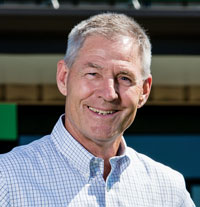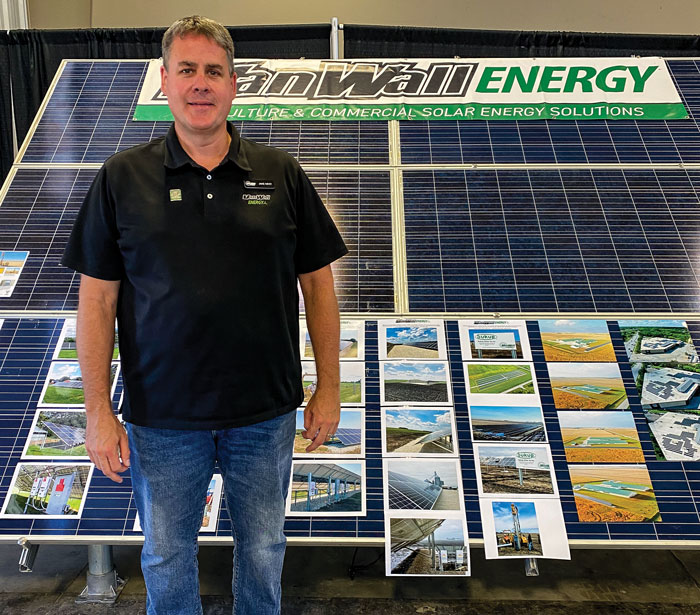Van Wall Equipment expanded its business in 2009 to include renewable energy after meeting with BTI, a John Deere dealer in central Kansas that was an Endurance Wind distributor. The dealership set up a separate business — Van Wall Energy — to sell the wind turbines, with the primary customer base being hog producers.
While the wind turbines were successful for Van Wall, it was tough to manage and maintain them. Eventually, the dealership transitioned to solar energy systems and dropped the wind system installations.
Farm Equipment sat down with Don Van Houweling, owner of Van Wall Equipment and Van Wall Energy, as well as Jake West, solar salesperson for Van Wall Energy, to get an update on how the company is doing with their solar energy solutions and what other dealers can learn from what they have done so far.

“I really believe it is important to help in the area of renewable energy. That was something I wanted to do to make an impact…” – Don Van Houweling
West has been with the company for over a decade and he says a lot has changed during that time.
“Seven years ago we switched 100% to solar energy and got away from wind energy just because there’s less maintenance involved with solar,” West says. “The cost to install it is quite a bit less and the last thing our customers want is something that is going to create more stress in their lives. Solar fits that bet really well.”
While it does have cost benefits, Van Houweling says his primary motivation for incorporating solar into his business was not all about cost efficiency.
“I really believe it is important to help in the area of renewable energy, and I felt like that was something I wanted to do to make an impact,” Van Houweling says.
Unlike their former wind energy operation which had a very specific target market, solar energy allows anyone to be a potential customer. But Van Houweling says from a business standpoint, it helps being in a region with a heavy agricultural population and also already having an established customer base that trusts his company.
“My customers already trust that if I put a system up for them, it’s gonna work and it’s gonna do what it’s supposed to,” Van Houweling says. “So I had a headstart in that way.”
From a sales standpoint, Van Houweling says it’s really no different than selling anything else because it is still about providing a product that is going to improve productivity, improve their bottom line and make them more competitive while reducing their risk.
Most of Van Wall Energy’s sales go to clients who are in Iowa, which is no coincidence according to West. And in terms of finding a selling point, he says it’s about educating the customer on the benefits of the product.
“Iowa is a great place to do solar. We have plenty of sunshine that grows our corn and our soybeans, so it’s all about educating people on how to take advantage of that sunshine,” West says. “And we want to show them how they can reduce some of their higher input costs, whether it’s hog operations, turkey or chicken operations or just on the farm itself. And it’s a long-term investment that’s going to last 20 or 30 years and can save them a lot of money.”
One way that Van Wall Energy has been able to attract a lot of customers is through its partnership with Iowa Farm Bureau.
“We are a partner of choice with the Iowa Farm Bureau,” West says. “For any Farm Bureau member who wants to do a solar project with us, we offer a $2,500 savings that goes toward up to 5 years of maintenance for free. So that partnership has been very beneficial, and we get a lot of customers from the Iowa Farm Bureau.”

Jake West, solar salesperson for Van Wall Energy, shows one of the company’s solar panel displays at the 2022 Farm Progress Show. Image Michaela Paukner
Van Houweling says from a dealer perspective, there are upsides and downsides to incorporating a system like this into your operation. But from a tax and financial standpoint there are a lot of benefits.
Between investment tax credits, grants and a relatively short ROI period, most profitable customers are looking at a ballpark estimate of 20-25 cents on the dollar for an investment to get a system put up on their farm according to Van Houweling.
West also added that with the latest update to the Inflation Reduction Act, financial options for small businesses looking to get started with renewable energy are favorable.
“The tax credits were at 26% on the federal side. With this additional funding, they are back up to 30% on the federal income tax credit. And that’s good for 10 years,” West says. “Also, there’s been a large amount of money allocated to the USDA REAP grant program (Rural Energy for America Program) and that helps farmers and small business owners get funding for solar. So with those two items, almost half of your project can be paid for from those tax credits and that grant.”
But even with those financial benefits, renewable energy still has its challenges and downsides.
“It’s an exceedingly great time to be banking that investment,” Van Houweling says. “The downside is there’s a shortage of equipment to build these systems. It would be tough to get into it now unless you had a relationship with a distributor, electricians and a plan to mitigate this equipment shortage.”
Another challenge Van Houweling brings up as a potential cautionary tale for dealers is that the laws surrounding utility companies and energy can differ from state to state.
“We’re really not the friends of these large utility companies because we’re creating energy they can no longer sell,” Van Houweling says. “So we are actually in competition with them. But for us, the laws in Iowa are very clear that they have to allow us to do it.”
West also talked about the overall goal of Van Wall Equipment and how Van Wall Energy fits into the scope and larger movement the company is striving for.
“It’s our vision to diversify the business and to help our customers be more profitable and reduce their risks,” West says. “We want them to be able to be more competitive in the marketplace, so this is one of very many ways they can do that.”







